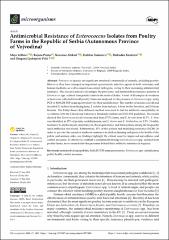| dc.contributor.author | Velhner, Maja | |
| dc.contributor.author | Prunić, Bojana | |
| dc.contributor.author | Aleksić, Nevenka | |
| dc.contributor.author | Todorović, Dalibor | |
| dc.contributor.author | Knežević, Slobodan | |
| dc.contributor.author | Ljubojević Pelić, Dragana | |
| dc.date.accessioned | 2024-07-22T07:48:17Z | |
| dc.date.available | 2024-07-22T07:48:17Z | |
| dc.date.issued | 2024 | |
| dc.identifier.citation | Velhner, M.; Pruni´c, B.; Aleksi´c, N.; Todorovi´c, D.; Kneževi´c, S.; Ljubojevi´c Peli´c, D. Antimicrobial Resistance of Enterococcus Isolates from Poultry Farms in the Republic of Serbia (Autonomous Province of Vojvodina). Microorganisms 2024, 12, 1483. https://doi.org/10.3390/ microorganisms12071483 | en_US |
| dc.identifier.issn | 2076-2607 | |
| dc.identifier.uri | https://repo.niv.ns.ac.rs/xmlui/handle/123456789/857 | |
| dc.description.abstract | Enterococcus species are significant intestinal commensals of animals, including poultry.
However, they have emerged as important opportunistic infective agents in both veterinary and
human medicine as well as major nosocomial pathogens, owing to their increasing antimicrobial
resistance. This research aimed to investigate the prevalence and antimicrobial resistance patterns of
Enterococcus spp. isolated from poultry farms in the north of Serbia. A total of 40 samples of overshoes
or feces were collected from 40 poultry farms and analyzed for the presence of Enterococcus spp. using
PCR or MALDI-TOF mass spectrometry for their identification. The number of isolates was 40 and
included 11 isolates from laying hens, 2 isolates from turkeys, 3 from broiler breeders, and 24 from
broilers. The Kirby–Bauer disk diffusion method was used to test for antibiotic susceptibility in
accordance with the Clinical and Laboratory Standards Institute and EUCAST guidelines. The results
showed that Enterococcus faecalis was isolated from 37.5% farms, and E. faecium from 42.5%. E. hirae
was identified in 15% of poultry establishments, and E. durans and E. thialandicus on 2.5%. Notably,
resistance to erythromycin, streptomycin, fluoroquinolones, and tetracyclines among the frequently
used antibiotics was found. Furthermore, 35% of the isolates had multidrug resistance (MDR). In
order to prevent the spread of antibiotic resistance in chicken farming and protect the health of the
public and animals alike, our findings highlight the critical need for improved surveillance and
control measures. To effectively establish a containment strategy for Enterococcus spp. isolated from
poultry farms, more research into the processes behind their antibiotic resistance is required. | en_US |
| dc.description.sponsorship | This research was funded by the Ministry of Science, Technological Development and
Innovation of the Republic of Serbia, grant numbers 451-03-66/2024-03/200031 and 451-03-66/2024-
03/200143. | en_US |
| dc.language.iso | en | en_US |
| dc.source | Microorganisms | en_US |
| dc.subject | antimicrobial susceptibility | en_US |
| dc.subject | MALDI-TOF mass spectrometry | en_US |
| dc.subject | Enterococcus spp. identification | en_US |
| dc.subject | public health | en_US |
| dc.subject | control measures | en_US |
| dc.title | Antimicrobial Resistance of Enterococcus Isolates from Poultry Farms in the Republic of Serbia (Autonomous Province of Vojvodina) | en_US |
| dc.type | Article | en_US |
| dc.identifier.doi | 10.3390/microorganisms12071483 | |
| dc.citation.volume | 12 | en_US |
| dc.citation.issue | 1483 | en_US |
| dc.citation.spage | 1483 | en_US |
| dc.citation.rank | M22 | en_US |
| dc.type.version | published | en_US |

